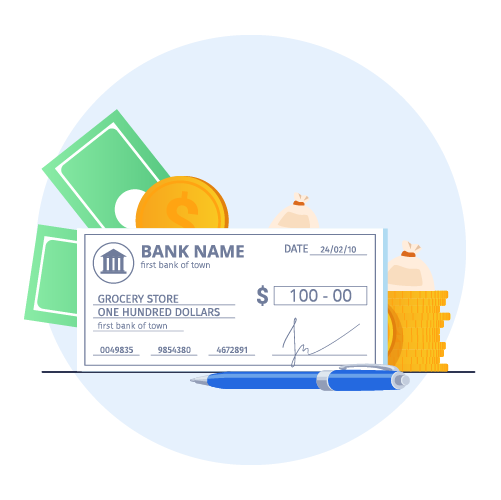
Safest Way to Send Cheques Through Mail
Individuals and businesses could consider using Canada Post’s Registered Mail service to acquire proof of mailing and the signature of the addressee or their representative while sending cheques. Xpresspost Certified is another great option to capture the recipient’s signature upon delivery. The cheque is returned to the sender if the recipient refuses to sign.

Users must take extra precautions while mailing cheques. It is never advisable to send cash or money orders via mail. Avoid mentioning extra details in your cheques to avoid stealing sensitive information, forgery, or counterfeit cheques. With restricted cheques, you can assign a specific payee to it. This step makes the cheque available only for deposits.
Colorful envelopes or greeting cards are another great way to hide your cheques from prying eyes. You can also directly visit the Post Office or use trusted mailing services to send the cheque if you are skeptical about its security. It’s a wise decision to track the progress of your cheques in real time with the tracking numbers you got from the Post Office. Many individuals and businesses inform the recipient before getting confirmation upon receiving the cheque. It is still a reliable way to make payments.
Key Takeaways
- Users must take enough measures to enhance the security of their payments and personal information.
- Registered Mail is the ideal service for sending cheques securely and timely.
- Restricting cheques is the number one weapon against all types of forgery and fraud.
- Hiding cheques with colorful envelopes or greeting cards could help you avoid unauthorized access.
- Users should consider using tracking numbers for the real-time progress of their cheque delivery.
- International check deliveries could take up to a few weeks to arrive.
- It is necessary to secure your checks to avoid stealing sensitive information and fraud.
Well, if you ask us—we would say regular mail works fine, but you can take measures to enhance the security of your payments and protect your personal information.
How?
Well, PostGrid facilitates safe cheque mailing and can help you fulfil your payments on time and without any hassles. Moreover, our platform can assist you in drafting and printing cheques.
Our all-in-one services let you reduce your workload and mail your cheques affordably, effectively, and safely. It also facilitates the cheque-by-mail payment method.
However, we know you are still sitting back, scratching your head with many questions. And, to help you out with the same, we have compiled everything you need to know about mailing cheques safely.
Let’s dive deep into this topic to find out!
What Precautions Should You Take to Mail Checks Safely?
The answer is simple– you can use the services of Canada Post or other mailing vendors. However, according to our experts at PostGrid, direct mail is the best way to mail a cheque if done correctly. A few precautions can make it an effective way to make timely payments.
Businesses and individuals need to take extra care about some things. This way, they can print and mail cheques confidently and accurately. You can ensure that all the cheques reach the respective clients without any issues in transit.
Below are some of the precautions through which you can send them in the mail safely.
1. Never send cash or money order
It would help if you never considered making your payments in cash. Anyone can steal and use it. Moreover, you can’t limit anyone from using that money. Sending cash in the mail is not recommended.
The Canada Post guidelines also prohibit sending cash by mail. It can cause an increase in the number of lost mail items, directly contributing to your company’s losses. Instead, always use a mailed cheque payment.
Although cheques can be forged and spammed, it is still possible to take precautions to avoid this from happening. Besides, you should not send cheques that are payable in cash. The most crucial thing to remember is never to mention “cash” in the payee field.
You can consider how to send a cheque online. Online mailing services like PostGrid can help you draft your cheques as well.
2. Avoid mentioning extra details
Many people add their social security, credit card, driver’s license, and phone numbers to their cheques. It can prompt criminals to misuse your sensitive information.
Thus, always avoid mentioning any extra details and be careful about everything you write on them.
How to send a cheque to someone without mentioning any extra details?
For this, you must know the information you must mention on the cheque and the details you may avoid. Everything should be exact, and only as much as needed. This step can safeguard you from a lot of trouble.
Along with avoiding mentioning extra details, always fill in the amount and payee fields. If the payee field is left blank, anyone can address the cheque to themselves and encash it easily from your bank. Many people think– is it safe to send a cheque in the mail? In reality – it is only possible if you write your cheques smartly.
3. Restrict your cheques
Restricting your cheques is an effortless step. But this small step is the greatest weapon against all types of forgery and fraud. Even if a person manages to steal your cheque, the limitations will block him from encashing that cheque with forged details and signatures.
When you restrict a cheque, you assign a specific payee to it. You can learn how to mail a cheque for a deposit only. You must include the words “for deposit only.” It prevents third parties from interfering and gets the cheque cashed under their name.
Mentioning the payee’s full name and other details allows the bank to remit payments only to a particular bank account. Consider knowing– what does a mail cheque mean?
Only the addressed person or organization can cash a mailed cheque, restricting others from misusing it.
4. Use colourful envelopes
Special envelopes provide more safety for your cheques. Many people use dark-coloured envelopes to mail cheques. Dark colours prevent thieves from knowing your envelope’s contents.
It is the safest way to send money by mail. The postal services also allow you to bring your cheque envelope for mailing. Otherwise, you can ask the Post Office to give you one.
Security envelopes are also available at the Post Office and office supply stores, primarily to conceal the contents of an envelope and keep them intact.
So is it safe to mail a cheque by hiding it? The answer would be: to a great extent.
5. Hide your cheques using greeting cards
Although coloured envelopes are a great way to hide your cheques, several other methods exist. The safest way to send a cheque through the mail while hiding it is to make it look like a postcard or letter—useless to the frauds.
You must know how to send money safely through the mail in a way that is not suspicious to thieves or fraudsters. If the mail items land in their hands, they should not feel tempted to open them.
Once they know it is a cheque, they can apply several methods to forge it and transfer the money to their account. Hence, hiding your cheque or making it look regular can help safeguard it.
Please note: Do not fold cheques because it might make them unreadable. You can hide your cheques by folding the thick paper around them. By folding several times, you can hide the contents more precisely.
Alternatively, you can send a greeting card to your clients while enclosing the cheque within the card. Pick a greeting card relevant to the season or an upcoming festival. Put a check inside a greeting card for added security.
There are two benefits to hiding your cheques in greeting cards: it acts as great material to make your clients happy and helps your mail reach the intended people safely.
6. Carry your cheques to the Post Office Personally or use trusted mailing services
You should carry your cheques to the Post Office if you print and mail them in-house. You can be relieved that at least your business or personal checks reached the Post Office safely– after which you can leave it up to your mailing service provider to deliver them.
Otherwise, you can use PostGrid’s cheque printing and mailing services to conduct everything from processing, printing, stamping, folding, and stuffing to mailing. Our platform and API can help you automate the entire process and ensure the safe mailing of your cheques.
With PostGrid, you don’t have to ponder: can you mail a cheque to someone or send a cheque through email? You can rest assured that we can get the job done securely. PostGrid can also help you draft your cheques quickly, letting you email a digital copy to the payee.
7. Track all your cheques
You receive the tracking numbers after shipping your cheques in the mail. Through these details, you can track the progress of your cheques in real time.
It ensures that the Post Office processes and transfers them from one unit to another, ensuring they arrive on time and without any unwanted delays. Delays in the delivery of cheques can increase the chances of fraud.
Hence, the mailers must arrive accurately and in the shortest possible time. Using PostGrid’s automation platform, you can get the tracking numbers immediately after shipping and view the reports anytime.
Our platform also provides delivery confirmations so you can track the arrival of your cheques.
If you want to know how to send a cheque via mail, below are some other things you may take care of. To send a cheque by courier, you need to follow all these steps carefully simply:
Monitoring your accounts
Companies and individuals need to regularly check their bank accounts and keep an eye on suspicious activities. This step can help spot fraud immediately, allowing you to stop payment on the check.
Many banks prompt customers to set up notifications or alerts to inform them of suspicious login attempts and transactions. With online and phone banking, it is easy for you to check your account frequently. It is one of the most significant steps in knowing how to send money through the mail. You should monitor your accounts smartly.
Use cashier cheques
You draw cashier cheques, and the bank fulfils the payment with its funds. The bank guarantees that it will honour the payment, avoiding bounced cheques. Sending a cashier’s cheque in the mail is a dependable payment form.
These cheques typically come with extra security features. Personal cheques are prone to theft and fraud. But, in the case of cashier cheques, it is much more difficult for spammers to write over and misuse them. You should know how to mail a cashier’s cheque because it provides advanced safety.
Sending a certified cheque in the mail
Encashing certified cheques requires the payee to sign the receipt form before receiving them. This receipt goes to the payer with the payee’s signature as proof of receipt. It can help block imposters from receiving the mail.
Furthermore, their signature can help catch them in case of any fraud. Ask your Post Office how to mail a certified cheque, and use them for frequent mailing. However, PostGrid can help you send certified mail cheques without visiting the Post Office.
 Also Read: Print Media: Uses, Benefits, Types
Also Read: Print Media: Uses, Benefits, TypesTime Involved in Sending Checks Through the Mail
Since cheques are time-bound and sensitive documents, they must reach the recipients on time. Moreover, speedy deliveries help secure them from criminals. The faster the delivery, the fewer the chances of fraud.
Therefore, before mailing a cheque, consider the time involved. For better convenience, contact your mailing vendor and request the estimated time to ship a document.
The Canada Post has different mailing options– which you can select according to your cheque’s urgency and needs. If the idea of sending a cheque in the mail is unclear, you can always talk to your mailing vendor and clear up all doubts. Facilitating quick and efficient deliveries can also help strengthen the relationship between you and your clients.
- If you select the Standard Mail option to send your cheques through Canada Post, your mail will arrive at the intended recipient’s home or office in 3-6 working days.
- The second option is Priority Mail, which delivers your mail items within 1-3 business days. Most companies opt for this option, as mailing cheques is convenient and affordable. You can ask the staff at the nearest Post Office about the best way to send a large cheque. They will guide you about sending large cheques in the mail and the time involved.
- The First-Class Mail option by Canada Post may sound like Priority Mail. But the name states the document’s size. It is cheaper than Priority Mail and delivers in the same time frame. However, Priority Mail items get high priority in the shipping infrastructure. Hence, the ultimate delivery period is the same, but the Priority Mail option is safer.
- Another option available with Canada Post is Express Mail. This option is the fastest way to mail a cheque and delivers it within 1-2 business days or overnight, in some cases.
International mail items can take up to a few weeks to arrive. Hence, send your cheques in advance so they reach the destinations before the last date to encash them.
Consult your mailing vendors and choose a mailing option that best suits your needs. Select a vendor after knowing their views on how to mail a cheque safely. If their services are safe and reassuring, you can confidently choose them as your mailing partner.
 Also Read: Difference Banks Drafts Vs Certified Cheques
Also Read: Difference Banks Drafts Vs Certified ChequesWhy Do You Need to Take Precautions While Mailing a Cheque?
There are many reasons why sending cheques through the mail is risky. Below are some of the primary reasons you need to take care of your cheques and ensure that they arrive securely:
Stealing sensitive information
Your cheques may get lost in transit or stolen only sometimes. Often, your cheques reach the intended recipient safely. But thieves have already copied and stored your account information and other details.
They might misuse these details to transfer funds from your account online or shop with your funds. Either way, your bank account is in serious trouble if your account information reaches the wrong person.
A check is never tracked during transit or after it reaches its destination. Therefore, it is crucial to ship it with the highest security levels.
Can you fold cheques to safeguard them? You should know that it is not advisable to fold them. Instead, use paper to cover your sensitive details.
Protection from frauds
If someone steals your cheque when you send it via mail, you must report them within a certain number of days. You must do so to ensure the Post Office entertains your case and you don’t bear the entire loss.
Hence, if someone fraudulently steals money from your account through a cheque, you should immediately report it to your bank. Although your bank will offer some protection to you, it must ensure that you will receive the entire amount back in your account.
Therefore, it is best to learn how to mail a cheque for a deposit and do the needful.
 Also Read: Transit Number Vs Branch Number
Also Read: Transit Number Vs Branch NumberCounterfeit cheques
Counterfeit cheques are fake cheques spammers create using other people’s account details. It helps them steal money from their accounts. Many cheques are counterfeit and fraudulent transactions happen almost daily. Altered cheques and forged signatures are other risks associated with cheque mailing.
To prevent someone from creating counterfeit cheques, learn how to send a cashier’s cheque in the mail. Cashier cheques are safer and better for mailing.
These risks will surely make companies and individuals ponder how to send money through the mail. If done correctly, sending cheques in the mail is safe.
Using PostGrid’s online cheque mailing services, you can rest assured your mail will arrive on time.
 Also Read: How to Ship Important Documents By Mail
Also Read: How to Ship Important Documents By MailUsing Postgrid’s Cheque Mailing Services
PostGrid’s automation platform and API can help you send your cheques safely via mail. It can assist you in every step of the mailing process and assure you that all your cheques will reach your clients safely and efficiently.
Connects with your CRM
You may connect PostGrid’s API to your payments or CRM software, enabling you to process your cheques quickly and conveniently. Furthermore, the main benefit of this integration is that you don’t have to stress about drafting your cheques.
Our platform can take care of filling out the necessary details accurately, limiting additional information, restricting the cheques, and ensuring that your cheques block criminals from misusing them.
Can you mail a cheque manually? Sure, but the manual process of drafting cheques is prone to human errors. Even the slightest mistake can cause the forging or counterfeiting of cheques. Therefore, it is of utmost importance that you draft them carefully and take the necessary precautions.
Event-triggered mail items
Sending event-triggered cheques is helpful when honouring payments frequently. It can help you automate your mailing tasks and get them done without needing time-to-time manual commands. PostGrid can set up specific dates and events beforehand, enabling you to mail cheques upon these triggers.
All the tracking reports for these event-driven cheques are available for you at any time. Hence, you can track and view the status of the cheques you sent on-demand or using specific triggers. Companies can easily focus on how to send money in the mail safely and on time with the help of PostGrid’s platform.
Reporting
Every cheque that goes through PostGrid’s platform or API has detailed logs. The progress and delivery reports are available on your dashboard, from where you can track the status of your cheques.
This feature is available to you free of charge. It can help you track your mail items and know when they get delivered.
If there are issues or the cheque’s delivery takes time, you can immediately contact your mailing vendor to find out why. This step can safeguard your cheques, as you can immediately stop the payment by calling your bank – in case of fraud alerts.
The next time you think about sending a cheque by mail, remember that PostGrid can do it for you.
Mailing options
PostGrid provides all the mailing options that we discussed earlier. You can select from the available alternatives as per your needs. Our platform ensures that all your cheques follow the postal regulations laid down by Canada Post. Moreover, PostGrid is a SERP-verified and PIPEDA-compliant platform.
MICR Printing
At PostGrid, we understand the benefits of Magnetic Ink Character Recognition Line printing and its ability to facilitate the utilization of routing numbers securely. The financial services industry is not immune to fraud.
MICR printing can help prevent financial fraud using special magnetic ink with a unique font. Additionally, this printing technology makes an alteration more difficult.
As a result, PostGrid’s automation platform and cheque API offer the safest way to mail a cheque. If you want to send a cheque in the mail, PostGrid offers secure mailing and assists you in every step.
 Also Read: How to Read a Canadian Cheque Micr
Also Read: How to Read a Canadian Cheque MicrConclusion
Undoubtedly, there are possibilities of cheque forgeries and misuse. When mailing a cheque, there are always concerns about its safety. However, there are several methods through which you can combat these frauds and get your mail delivered securely.
But with PostGrid, you no longer need to worry about how to mail a cheque to someone. We take several precautions to ensure that nobody touches your cheques and that they arrive efficiently.
Our team of professionals understands that restricting the cheques to using security envelopes and using MICR printing is crucial when sending cheques in the mail daily.
Lastly, PostGrid’s printing and mailing services can help you send cheques securely. Using our platform and postal API, you can complete your payments promptly and securely.
If you still have concerns about how to mail or send a cheque via mail, you can talk to us to learn more about PostGrid’s cheque mailing services.
 Also Read: What is Positive Pay?
Also Read: What is Positive Pay?









